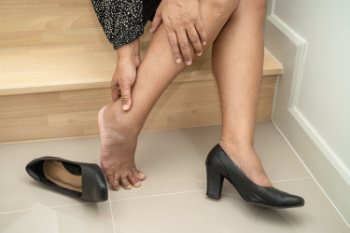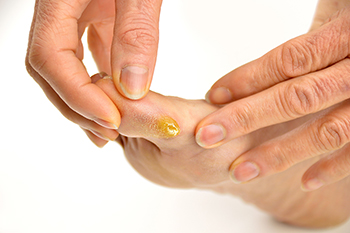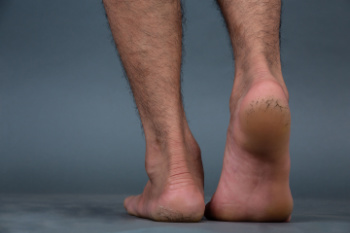Items filtered by date: October 2024
Treatment for Foot Pain

Foot pain can occur in various areas, including the heel, arch, toes, and ball of the foot. Common causes include plantar fasciitis, which affects the heel and arch due to overstressed ligaments, bunions, causing pain at the base of the big toe, and metatarsalgia, which leads to pain in the ball of the foot from high-impact activities or ill-fitting shoes. Conditions like Achilles tendinitis, flat feet, and arthritis can also contribute to discomfort in different parts of the foot. Managing foot pain depends on the cause. Wearing supportive footwear and rest is the beginning of relieving pain from overuse or minor injuries. For persistent or severe pain, it is suggested that you visit a chiropodist for a diagnosis of any underlying problem and treatments to alleviate symptoms and restore function.
Foot pain is a common problem treated by chiropodists. If you have foot pain, please consult with one of the chiropodists from Complete Family Footcare & Therapy. Our clinicians can help you maintain the health of your lower limbs and your mobility.
When you are experiencing foot pain, it’s important to note the type of pain and its location, as this can help determine a diagnosis.
Pain in the top of the foot may be caused by:
Stress fractures
Sinus tarsi syndrome
Extensor tendonitis
Tibialis anterior tendonitis
Gout
Athlete’s foot
Ganglion cysts
Pain in the bottom of the foot may be caused by:
Plantar fasciitis
Foot cramps
Tarsal tunnel syndrome
Plantar fibromatosis
Posterior tibial tendonitis
Stress fractures
Flat feet
Pain on the side of the foot may be caused by:
Ankle sprain
Cuboid syndrome
Peroneal tendonitis
Stress fractures
Bunions
Corns or calluses
Posterior tibial tendonitis
Heel pain may be caused by:
Plantar fasciitis
Achilles tendonitis
Bone spurs
Heel fractures
Retrocalcaneal bursitis
Sever’s disease
Pain in the toes may be caused by:
Gout
Hammertoe
Turf toe
Bunions
Ingrown toenails
Blisters
Arthritis
These and many more conditions can be treated by a chiropodist. If you have any questions, please feel free to contact our offices located in . We offer the newest diagnostic and treatment technologies for all your foot care needs.
How Corns and Calluses Differ

Corns and calluses are both thickened areas of skin that develop due to repeated pressure or friction, often from wearing tight shoes or spending long hours on your feet. While they are similar, they have key differences. Corns are smaller, more concentrated, and usually form on parts of the feet that do not bear weight, like the tops or sides of toes. They can be painful due to their hard center pushing into deeper layers of skin. Calluses are larger, flatter patches of thickened skin that commonly develop on weight-bearing areas like the soles. They are generally less painful but can cause discomfort. To find temporary relief for painful corns and calluses, wear well-fitting shoes and use padding to reduce pressure. If you have persistent or painful corns or calluses, it is suggested that you visit a chiropodist for proper care.
Corns are small bumps or dry, hardened skin that can arise on the feet, usually in response to friction. Corns can be asymptomatic, or they can be uncomfortable or painful. If you have corns that are bothering you, please consult with one of the chiropodists from Complete Family Footcare & Therapy. Our clinicians can help you maintain the health of your lower limbs and your mobility.
There are three types of corns:
Hard corns
Often occur on the tops of toes
Feature a hard core surrounded by dry, irritated skin
Can be painful
Soft corns
Often occur in between the toes
Soft due to constant exposure to sweat
Can be painful
Seed corns
Tiny
Often occur on the soles of the feet
Usually asymptomatic
Corns can be prevented by wearing shoes that fit properly. They are typically benign and don’t require medical treatment. However, if your corns are causing you pain or discomfort, don’t hesitate to reach out to a chiropodist near you for treatment options. If you have any questions, please feel free to contact our offices located in . We offer the newest diagnostic and treatment technologies for all your foot care needs.
Getting up From a Fall

While fall prevention is key, knowing how to safely get up after a fall is equally important, especially for older adults. After a fall, it is important to remain calm and assess injuries before attempting to stand. If you are uninjured, roll onto your side and rest to avoid dizziness. Slowly move onto your hands and knees, then crawl toward a sturdy piece of furniture like a chair or bed. Use both hands to support yourself on the furniture and, if possible, bring one leg forward, placing your foot flat on the floor. Push up with your arms and legs to stand slowly. If you are injured or cannot get up, try to find a comfortable position and call for help. If you have sustained foot or ankle injuries from a fall, it is suggested that you consult a chiropodist for care and further advice on fall recovery.
Falls are a common but preventable problem for older adults. If you would like to learn more about preventing falls, please consult with one of the chiropodists from Complete Family Footcare & Therapy. Our clinicians can help you maintain the health of your lower limbs and your mobility.
Did you know that most falls occur in the home? Fortunately, there are many simple changes that you can make to the living environment to reduce the risk of falling.
In the Bathroom:
Install grab bars near toilets, bathtubs, and showers
Put non-skid mats on all surfaces that may get wet
In the Bedroom:
Keep a light near the bed so that you can easily turn it on if you have to get up at night
Keep the path from your bedroom to the bathroom clutter-free and well-lit
Consider installing a bed rail for added support
In the Kitchen:
Use non-skid mats
Wipe up any spills immediately
Move commonly used items to areas that are easily within your reach
In the Hallways:
Place handrails on both sides of the stairs
Install good lighting in the hallways and around the entire home
Keep hallways free of clutter
Don’t use throw rugs or small area rugs
In Other Living Areas:
Keep loose cables, cords, and wires near the wall and away from walking surfaces
Make sure that all carpets and rugs are secure firmly to the floor
Arrange your furniture so that it is not in your way when you walk
Use chairs and couches that you can easily get up from
If you have any questions, please feel free to contact our offices located in . We offer the newest diagnostic and treatment technologies for all your foot care needs.
Pain Relief From Working on Your Feet

Working on your feet for long periods can lead to a variety of negative effects on foot health, including pain, swelling, and fatigue. Prolonged standing or walking puts constant pressure on the feet. It increases the risk of developing conditions like plantar fasciitis, bunions, and heel spurs. This can also lead to joint pain, muscle strain, and issues like varicose veins. Over time, improper foot support or inadequate footwear may worsen these problems, leading to chronic pain or more serious complications. Proper foot care is essential to prevent these issues. Wearing supportive shoes, using cushioned insoles, and regularly stretching can help alleviate discomfort. However, if foot pain persists despite these efforts, it is suggested that you visit a chiropodist.
If you stand all day, you may be at an increased risk of developing various foot conditions. If you are experiencing foot pain of any kind, please consult with one of the chiropodists from Complete Family Footcare & Therapy. Our clinicians will assess your condition and provide you with quality foot and ankle treatment.
What Foot Problems Are Caused by Standing?
Standing all day at work may increase your risk of developing foot or ankle problems.
Some common foot conditions that may arise from spending all day on your feet include:
Foot pain
Blisters
Corns and calluses
Arthritis
Flat feet
Bunions
Sprains
Athlete’s foot
Prevention
If you stand for prolonged periods of time for work, taking preventative measures to preserve the health of your feet is strongly recommended.
Measures you can implement to help prevent foot problems include:
Wearing shoes that are comfortable and fit well - these shoes should be made of breathable materials and provide you with arch support and cushioning. It is best to avoid shoes that have heels or narrow toe boxes.
Taking breaks to rest, walk, and stretch your feet throughout the day
Maintaining good foot hygiene - wash and dry your feet thoroughly every day
If you have any questions, please feel free to contact our offices located in . We offer the newest diagnostic and treatment technologies for all your foot care needs.
Gout Pain Can Be Managed
Definition and Causes of Cracked Heels

Cracked heels, also known as heel fissures, occur when the skin on the heels becomes dry and thickened, leading to painful splits. Common causes include prolonged standing or walking, especially on hard surfaces, which can put extra pressure on the heels. Dry skin, often made worse by cold weather or low humidity, contributes significantly to the condition heel fissures. Medical conditions like diabetes and eczema can also increase susceptibility. To prevent cracked heels, it is important to maintain proper foot hygiene by regularly moisturizing and exfoliating the feet to remove dead skin. Wearing well-fitting shoes that provide adequate support and cushioning can help reduce pressure on the heels. Avoiding walking barefoot on hard surfaces and keeping hydrated supports overall skin health, further reducing the risk of developing cracks. Cracked heels can be painful and can hinder completing daily activities. If you have developed this condition, it is suggested that you schedule an appointment with a chiropodist who can offer you effective treatment solutions.
Cracked heels, also known as heel fissures, can cause pain and discomfort. If your cracked heels are bothering you, please consult with one of the chiropodists from Complete Family Footcare & Therapy. Our clinicians will assess your condition and provide you with quality foot and ankle treatment.
Dry, thickened skin around the rim of the heel is typically the first sign of cracked heels. While this condition is common and usually just a nuisance, some cases can be more severe. If left untreated and as more pressure is placed on the heel, the cracks become deeper and eventually walking and standing can be painful. These deep cracks or fissures can bleed and also become infected. Those with diabetes need to be especially careful as fissures could lead to diabetic foot ulcers.
Causes
Cracked heels can be the result of several different factors, including:
Dry skin
Taking long, hot showers or using harsh soaps
Standing for long periods of time
Walking barefoot
Walking in shoes with an open back, such as sandals or flip flops
Wearing shoes that do not fit properly
Living in a cold or dry climate
Certain skin conditions, such as eczema or psoriasis
Treatment
There are many at-home treatment remedies for cracked heels. Applying moisturizers to the heel can help hydrate the skin. Soaking your feet in warm water and exfoliating them with a loofah or pumice stone can help to buff away dead skin cells. If you are afflicted with cracked heels, it is recommended that you see a chiropodist for treatment.
Prevention
You can prevent cracked heels by:
Avoiding standing in one position for prolonged periods of time
Wearing well-fitted shoes with a closed back
Washing your feet with gentle soaps and lukewarm water
Moisturizing the feet daily
If you have any questions, please feel free to contact our offices located in . We offer the newest diagnostic and treatment technologies for all your foot care needs.

